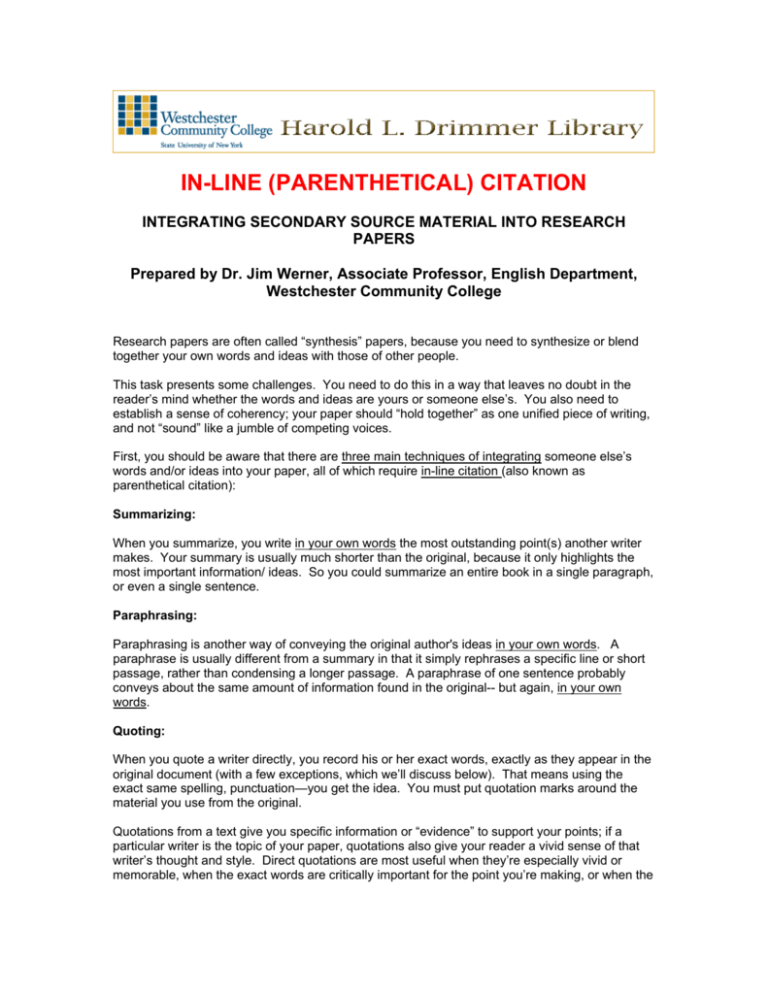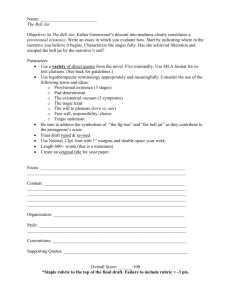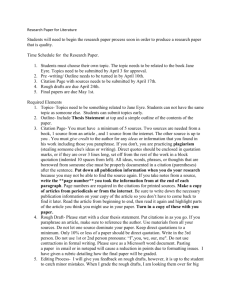
IN-LINE (PARENTHETICAL) CITATION
INTEGRATING SECONDARY SOURCE MATERIAL INTO RESEARCH
PAPERS
Prepared by Dr. Jim Werner, Associate Professor, English Department,
Westchester Community College
Research papers are often called “synthesis” papers, because you need to synthesize or blend
together your own words and ideas with those of other people.
This task presents some challenges. You need to do this in a way that leaves no doubt in the
reader’s mind whether the words and ideas are yours or someone else’s. You also need to
establish a sense of coherency; your paper should “hold together” as one unified piece of writing,
and not “sound” like a jumble of competing voices.
First, you should be aware that there are three main techniques of integrating someone else’s
words and/or ideas into your paper, all of which require in-line citation (also known as
parenthetical citation):
Summarizing:
When you summarize, you write in your own words the most outstanding point(s) another writer
makes. Your summary is usually much shorter than the original, because it only highlights the
most important information/ ideas. So you could summarize an entire book in a single paragraph,
or even a single sentence.
Paraphrasing:
Paraphrasing is another way of conveying the original author's ideas in your own words. A
paraphrase is usually different from a summary in that it simply rephrases a specific line or short
passage, rather than condensing a longer passage. A paraphrase of one sentence probably
conveys about the same amount of information found in the original-- but again, in your own
words.
Quoting:
When you quote a writer directly, you record his or her exact words, exactly as they appear in the
original document (with a few exceptions, which we’ll discuss below). That means using the
exact same spelling, punctuation—you get the idea. You must put quotation marks around the
material you use from the original.
Quotations from a text give you specific information or “evidence” to support your points; if a
particular writer is the topic of your paper, quotations also give your reader a vivid sense of that
writer’s thought and style. Direct quotations are most useful when they’re especially vivid or
memorable, when the exact words are critically important for the point you’re making, or when the
2
language itself is the topic of discussion. If none of these apply, you might want to consider using
a paraphrase to keep the “voice” of your paper more consistent.
[See the section at the end of this document for examples of effective quotation, paraphrase and
summary, as well as an example of plagiarism.]
In-line Citation:
Take a look at the material in parentheses at the end of the following sample sentences:
Debra Winthrop suggests that “we’re all potential winners in this game” (365).
Some people feel that “we’re all potential winners in this game” (Winthrop 365).
That’s called in-line citation. If you’re writing a paper for an English class at Westchester
Community College, that means you need to use MLA (Modern Language Association)
documentation format, which requires both in-line citation and a Works Cited list (described
below)* and on the library website at http://www.sunywcc.edu/library.
In-line citation is important. It provides the reader with just enough information to locate the
source in the Works Cited List at the end of the paper. However, it presents only a minimal
distraction from the text as someone reads your paper.
You should follow the punctuation in the above models exactly for standard shorter quotations.
Do not write "page" or "p." or "pp." in your citation.
* A Works Cited list is different from a bibliography; the first lists ONLY the works that you actually
cite (quote, paraphrase, etc.) in your paper, while the second lists ALL the works you have
consulted (even those you don't quote, etc.) in writing your paper.
Some general hints:
•
Cite all quotations (borrowed words) and paraphrases (borrowed ideas), except
general/common knowledge. A good rule of thumb: when in doubt, give a citation!
•
Use signal phrases, often naming the author, to integrate your quotations into your paper.
Avoid “dropped” or “floating” quotes. Set up direct quotations with your own introductory
or transitional phrase:
Incorrect: Evan Smith disagrees. “New teachers are burning out faster” (32). [“floating” or
“dropped” quotation]
Correct: Evan Smith maintains that "new teachers are burning out faster" (32).
One easy way to avoid “drop-in” quotations is to use a full colon (:) if your
“lead-in” phrase is a full sentence (independent clause).
Example: Evan Smith identifies one main problem: “new teachers are burning out faster"
(32).
•
Be sure to put author's last name in parentheses if it's not in the introductory phrase.
Example:
3
Some writers argue that "new teachers are burning out faster" (Smith 32).
•
Use only the section of the quotation that’s needed/useful. You must use ellipses (…) to
“stand in” for words you omit in the middle of a quotation (and if you wish, at the
beginning or end of the quoted material), but you should stay true to the quote’s original
meaning.
Original: This play was, I have to confess, the greatest waste of time and money I have ever
encountered. (from a review by Joe Schmoe page 21)
Correct: According to Joe Schmoe, “This play was… the greatest waste of time and
money…” (21).
Incorrect: According to Joe Schmoe, “This play was… the greatest…” (21).
•
Always be sure that the sentence incorporating your words and the author’s is
grammatically intact.
Correct: Joe Schmoe describes the play as “the greatest waste of time and money I have
ever encountered” (21).
Incorrect: Joe Schmoe, about the play, “the greatest waste of time and money I have ever
encountered” (21).
Note: To maintain grammatical correctness, you are permitted to alter the quotation in a
limited way by using brackets [ ].
Original: Every night, I creep down the stairs past my parents’ bedroom door and sneak out
the window. (From an essay by Jane Brain, page 4)
Correct: Jane Brain describes how she “creep[s] down the stairs” each night and “sneak[s]
out the window” (4).
The reader understands that the original has only been altered to maintain
subject-verb agreement.
•
•
For quotes longer than four lines of prose text: indent ten spaces (two tabs) for the entire
quotation (maintaining double spacing); omit quotation marks at the beginning and end of
the quote; and place parenthetical citation outside the period of the last sentence in the
quotation, after two spaces. Use these longer quotes SPARINGLY, only to capture style
or
Content of an entire passage.
Example:
In another tale, “King Pest,” Poe depicts a similarly jumbled, irregular and
confusing city which has become depopulated:
4
The paving-stones, loosened from their beds, lay in wild disorder amid the tall,
rank grass, which sprang up around the feet and ankles. Fallen houses choked
up the streets. The most fetid and poisonous smells everywhere prevailed;-- and
by the aid of that ghastly light which, even at midnight, never fails to emanate
from a vapory and pestilential atmosphere, might be discerned lying in the bypaths and alleys, or rotting in the windowless habitations, the carcass of many a
nocturnal plunderer arrested by the hand of the plague in the very perpetration of
his robbery. (243)
•
Introduce the author and his/her work by full name in your text when you first mention
him/her; you might even want to name the work you’re quoting or paraphrasing in this
initial mention.
Example: According to Tom Fielding, author of Why We Can’t Help Acting Like Monkeys,
human behavior is fairly predictable, and usually destructive (65).
After that, use only the author’s last name, either in your text or with the page number in the
parenthetical citation.
Correct: Fielding even apologizes to monkeys for insulting them with this comparison (66).
Incorrect: Tom even apologizes to monkeys for insulting them with this comparison (66).
•
Use signal phrases (and occasional reminders) also to indicate summaries and
paraphrases. Avoid the “lazy paraphrase,” in which you blend another writer’s ideas with
your own in a paragraph indiscriminately, and then “slap on” a citation at the end.
Correct:
According to Robin Trudeau, essayist and author of The Half-Empty Cup, people need to
remember the positive things in their lives to maintain a state of psychological equilibrium.
Trudeau also emphasizes the importance of positive thinking for health reasons. Of course,
this is not a new idea at all; many doctors have testified to the benefits of an optimistic
outlook in fighting diseases like cancer, AIDS and heart conditions. I myself have an aunt
whose recovery from heart disease was nothing short of miraculous. But Trudeau goes
further, asserting that positive thinking can be even more effective than medicine in living a
longer, healthier life (33-34).
Incorrect—a “lazy paraphrase” (Whose ideas are whose in this paraphrase?):
People need to remember the positive things in their lives to maintain a state of psychological
equilibrium. Positive thinking is important for health reasons. Of course, this is not a new
idea at all; many doctors have testified to the benefits of an optimistic outlook in fighting
diseases like cancer, AIDS and heart conditions. I myself have an aunt whose recovery from
5
heart disease was nothing short of miraculous. Positive thinking can be even more effective
than medicine in living a longer, healthier life (Trudeau 33-34).
•
If the author is unknown, use the full title of the work in a signal phrase, or an abbreviated
form of that title in the parenthetical citation (that’s how it will be found, alphabetically, in
your Works Cited page).
Examples:
According to the Olde Booke of Hoggwashe, the world was due to end April
15, 1999 (97).
Many ancient writers predicted that the world was due to end April 15, 1999
(Olde Booke 97).
•
If there are no page numbers (as is the case with many web sites), cite only the author’s
last name in text or in parenthesis.
Example: The web page for the ASPCA lists ten things you can do to prevent animal cruelty
(Smith).
CITATION AND PLAGARISM
The following is taken from Exploring Literature: Writing and Arguing about Fiction, Poetry, Drama
and the Essay, by Frank Madden (Pearson Longman, 2008), and is reprinted by permission of
the author.
Avoiding Plagiarism
Plagiarism is taking someone else’s ideas or words and passing them off as your own. The most
basic rule of all documentation is that direct quotations and summarized or paraphrased
information or ideas from another source must be appropriately credited. This includes
information that is not common knowledge (information that you would not have without reference
to this or a similar source), information or ideas from another source that you have paraphrased
or summarized, and direct quotations from another source.
You must always make it clear which words and ideas are yours and which ones come from
other sources. Before you submit your essay, check your paraphrases and summaries against
the original sources. Make sure that the words and sentences are your own and that they
accurately reflect the meaning of the source material. To use other people’s words and ideas and
not give them credit is a serious academic offense.
6
Examples of Paraphrasing, Summarizing, Quoting, and Plagiarizing
The Original Source
(From Shulevitz, Judith. “The Hall of Fame.” Rev. of Genius, by Harold Bloom. New York
Times Book Review 27 Oct. 2002.)
Bloom is not so easily dismissed, however. His style may be disheveled and his book
shockingly attuned to the demands of the marketplace, but both have a virtue that trumps
those flaws. Bloom’s focus on genius is not just commercial opportunism, the usual blather
about the moral import of cultural literacy or part of the national obsession with success,
though critics will find all three if they go looking for them.
Summarizing
Shulevitz says Bloom’s book is stylistically “disheveled” and market driven, but these may
be greater strengths than weaknesses. She believes critics will reduce it to these
weaknesses if they want to, but the book has greater value than that (11).
Paraphrasing
Shulevitz says Bloom’s work remains important even though it seems a bit “disheveled” in
style and market driven. She asserts that these features of his writing are actually greater
strengths than weaknesses, and that this work is not just an attempt to make money by
taking advantage of the public’s desire for books about cultural literacy or success. But she
believes that critics will be able to reduce the book to these weaknesses if they want to, and
ignore its qualities (11).
Quoting
Shulevitz says Bloom’s work remains important and adds, “His style may be disheveled and
his book shockingly attuned to the demands of the marketplace, but both have a virtue that
trumps those flaws” (11).
Plagiarizing
Shulevitz insists that Bloom is not so easily dismissed. He may have a disheveled style and
his book is shockingly attuned to the marketplace, but both of these things have a virtue that
trumps those flaws.
© 2008 SUNY Westchester Community College Harold L. Drimmer Library/Learning Resource Center






